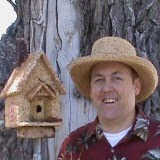
Now here's a critter that is very prolific in the mountain region of the U.S.
These little guys are a breath of fresh air. Although slightly different, there are similarities with the Eastern Bluebird. Here are some facts about the Mountain Bluebird.
A common sight in ranch land and other open areas of the American West, the male Mountain Bluebird is a breathtaking brilliant sky blue. It prefers more open habitats than the other bluebirds and can be found in colder habitats in winter.
ADULT DESCRIPTION:
These little guys are a breath of fresh air. Although slightly different, there are similarities with the Eastern Bluebird. Here are some facts about the Mountain Bluebird.
A common sight in ranch land and other open areas of the American West, the male Mountain Bluebird is a breathtaking brilliant sky blue. It prefers more open habitats than the other bluebirds and can be found in colder habitats in winter.
ADULT DESCRIPTION:
- Medium-sized songbird; small thrush.
- Head large and round.
- Body chunky.
- Tail medium length.
- Blue in wings and tail.
- Male sky blue overall.
Male Description:
Body, head, wings, and tail sky blue; brighter above, paler below. Belly white. Duller brownish blue in winter.
Female Description :
Brown-blue overall. Brighter pale sky blue on rump, wings, and tail. Head and back bluish gray. White eyering. Sometimes a faint malar streak. Chest may have some reddish. Some females are more brownish than others.
Youngster Description:
Juvenile with spotted chest and unspotted back, blue in wings and tail. Immature similar to adult but duller.
These are remarkable wildlife birds. For more information on how to help, house and attract bluebirds take a peak right here: http://www.wildlife-houses.com/product_info.php?cPath=1&products_id=13








